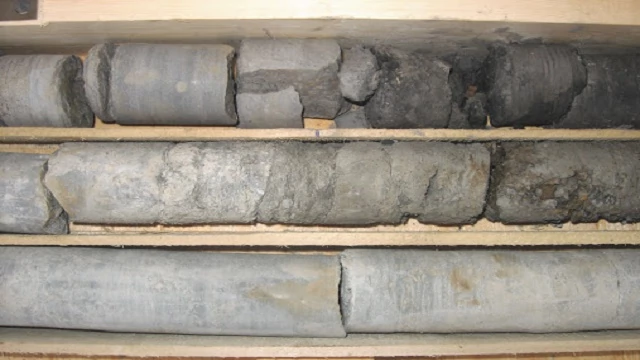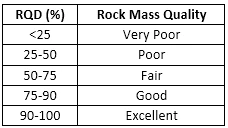RQD (Rock Quality Designation)- Calculation, Values & Limitations

Rock quality designation (RQD) helps in calculating whether the rock is useful or not for any task. It provides its results in the terms of percentage.
What is RQD (Rock Quality Designation)
Rock quality designation is also known as RQD. It is a rough idea about the degree of either joining or breaking of the rock mass. It is evaluate as a percentage of the core barrel which is of length 10cm or more than that. The rocks that are high in their quality have an RQD more than 70%. The rocks that have 50% RQD lie in the category of low-quality rocks.

Though there are multiple definitions of RQD but D.U. Deere in 1964 released the most appropriate definition. It is the type of borehole core recovery percentage. RQD helps in covering those pieces which are solid from their core and are longer than the length of 100mm that is measured with the help of centreline of the core.
Rock quality designation was deals with the cores of 54.7mm diameters. Its value helps calculate the support of the rock tunnels. RQD uses some of those systems that fulfill the requirement for the rock mass classifications. Some of them are Q-system and the Rock Mass Rating system.
How to Calculate RQD?
RQD is defined as a quotient of :
Core recovery (CR) = (total length of rock recovered / Total core run length)x100
and gives the result in a percentage.

After the calculation of the percentage of RQD, it helps in deciding the quality of the rock. Here is the list which will help you know the relation of RQD with the quality of rock. (The value of RQD are in percentage)
Values of RQD
| Value of RQD | Quality of Rock |
| 0-25 | Worst |
| 25-50 | Poor |
| 50-75 | Fair |
| 75-90 | Good |
| 90-100 | Excellent |
Limitations of Rock Quality Designation (RQD)
There are two limitations to it:
- Though it is a directional quantity because of its definition, it reacts more sensitively towards the direction of line. The hole as compared to the measurements of the frequency of the fracture or the joint spacing. RQD value is also variable as it depends on the direction of the run.
- This is one of the drawbacks of RQD as it limited to the core pieces that have a size greater than 10 cm. It provides no information for those particles which are less than this. It also does not care that the rejected piece is either of earth-like material or fresh rock.
Rock quality designation Slideshare is the App that holds all the information about the rock quality designation. It helps to know the benefits and the real use of it.
Test Methods of RQD
There are multiple RQD methods to test the quality of the rock by using rock quality designation. One of the standard tests is rock quality designation ASTM test. Here are some of the keys points of this test:
This test is used to determine the standard parameters of the rock quality designation as a part of drill core logging.
The values of the RQD that are either observed or calculated and should follow all the guidelines of the significant digits. It rounded off by using Practice D 6026.

In this standard test, there are multiple methods to perform different tasks. One of those methods is the method which deals with collection, calculation or recording of data. This method has no direct connection with the accuracy of the data. Usage of designing the model or for any other thing cannot take place in rock quality designation..
The values that are written in inch-pounds are considered to be the approximate values of the test. Whereas the values that are written in the SI units are the correct value that is predicted from the test.
The test does not take care of the safety or health issues of anyone, it is the duty of the users.
Guidelines for RQD
Calculated and should follow all the guidelines of the significant digits. It rounded off by using Practice D 6026.
In this standard test, there are multiple methods to perform different tasks. One of those methods is the method which deals with collection, calculation or recording of data. This method has no direct connection with the accuracy of the data. Usage of designing the model or for any other thing cannot take place in rock quality designation..
The values that are present in inch-pounds are considered to be the approximate values of the test. Whereas the values that are present in the SI units are the correct value that is predicted from the test.
